
YAKSHA – Service Offer 2018

Date:
01/01/2018 to 30/06/2020
Introduction
YAKSHA aims at reinforcing cooperation and building EU-ASEAN partnerships by developing a cybersecurity solution tailored to specific national needs leveraging EU Know-How and local knowledge. The project will enhance cybersecurity readiness levels for its end users, help better prevent cyber-attacks, reduce cyber risks and better govern the whole cybersecurity process. YAKSHA is ideally positioned to help secure the global manufacturing supply chains, given its focus on IoT Security.
Who is the project designed for?
YAKSHA has five main target groups as described below:
- SMEs and Large Corporations: YAKSHA will contribute to developing a safe cybersecurity environment that will create more opportunities for SMEs and large organisations, particularly those who use ICT as its main business model.
- Critical Infrastructure Organisations: YAKSHA will develop cyber-attack scenarios and promote cyber awareness to help critical infrastructure organisations increase their safety measures against server hacks, disclosure of data and improve the overall safety of their activities.
- Government Organisations: YAKSHA will contribute to developing a safe cybersecurity environment that will help government institutions better manage the confidential nature of their activities.
- Policy Makers related to International Cooperation in Cybersecurity: YAKSHA will address targeted ASEAN policy makers with state of the art reports and recommendations on the climate of cybersecurity in the region and in specific ASEAN countries
- Associations, Network of Organisations and other interested parties: YAKSHA will bring together associations and networks of organisations representing the interest of SMEs and large organisations active in the domain of cyber software or subject to cyber threats in order to raise awareness on safe cyber technology.
How is your project benefitting the end-user?
YAKSHA aims to provide an automated framework for deploying honeypots and correlating the collected information. The goal is to enable end-users, whether they are governments, organisations or companies, to easily set up customised honeypots, which will allow them to understand how their systems are being attacked on the wild, in an autonomous way.
YAKSHA will take into consideration particular needs of ASEAN countries in order to customize the software platform and co-create the ideal ecosystem and business model; and, secondly, promote field activities of engagement and business exploitation, which will allow its sustainability. In addition, YAKSHA will enhance cybersecurity readiness levels for its end-users, provide mechanisms to prevent cyber-attacks, reduce cyber risks and better govern the whole cybersecurity process.
Lastly, YAKSHA will also create YAKSHA Label of Excellence which is a European certification of technology excellence and will serve as a sustainable recognition of the product’s qualities after the project is finished. In the long run, there will be more end-users who prefer SMEs and large businesses who have YAKSHA’s label of excellence due to their increased safety and overall better cybersecurity management.
Please briefly describe the results your project achieved so far
Since YAKSHA's public launch in January 2018, the project has been able to develop its website, Newsletter and have been participating in numerous Cybersecurity and ICT events in Europe and Southeast Asia. In addition, YAKSHA has identified more than 500 Cybersecurity actors both in Europe and Southeast Asia.
These contacts represent important cybersecurity stakeholders from both regions and come from different background and expertise, including government agencies, universities, research institutes, large industries, SMEs, etc. Currently, YAKSHA is developing the ASEAN Cybersecurity Ecosystem Overview that will analyse the EU and ASEAN’s cybersecurity ecosystems status in order to assess the main opportunities for developing new solutions for improving the cybersecurity posture of complex organisations in the ASEAN area.
In addition, the project is developing the data collection methodology and architecture necessary for the YAKSHA pilots. This will include the general assumptions, limitations of the platform and identify the different entities involved, their attributes, behaviour, and interactions. Lastly, YAKSHA has also begin the preparation of YAKSHA Ambassadors´ deployment. YAKSHA Ambassadors´ are voluntary representatives of the YAKSHA project in the ASEAN countries and are active in the field of cybersecurity, software or more largely internet security and defence.
What are the next steps for your project?
The next steps for YAKSHA are the Co-creation workshops to be organised in Kuala Lumpur, Bangkok and Hanoi in September 2018. The workshops aim to identify current trends and possible optimal ecosystem, taking into account the social foundations, regional characteristics and network building.
The project will develop four versions of software in October 2018 (Prototype), February 2019 (Beta Version), August 2019 (Release Candidate) and June 2030 (Final Version) respectively. Finally, YAKSHA will also organise two end-user events, in October 2019 and April 2020. These end-user events will be focused on YAKSHA's software promotion and become part of its exploitation strategy.
Projects/Provider:
Resources for EU Research
Resources for SMEs
News & Events
Reports
Cyberwatching.eu has received funding from the European Union’s Horizon 2020 research and innovation programme under grant agreement No 740129. The content of this website does not represent the opinion of the European Commission, and the European Commission is not responsible for any use that might be made of such content. Privacy Policy | Disclaimer / Terms and Conditions of Use
